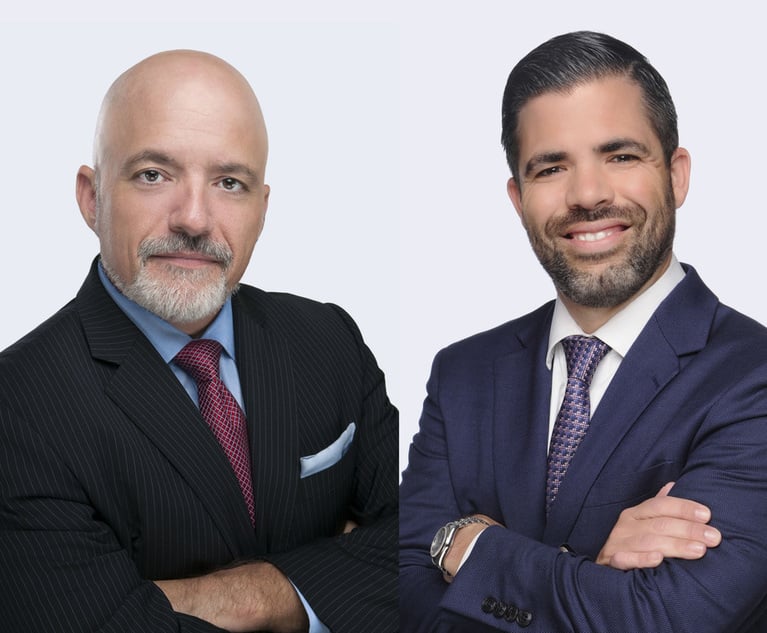 L-R: Marisa Rosen Dorough, Thomas H. Barnard, and McKenna S. Cloud of Baker Donelson. Courtesy photos
L-R: Marisa Rosen Dorough, Thomas H. Barnard, and McKenna S. Cloud of Baker Donelson. Courtesy photos Chevron Deference Discarded: SCOTUS Decision in Fisheries Cases Leaves Administrative Law Reeling
On June 28, the U.S. Supreme Court issued its highly anticipated ruling in a pair of cases challenging the long-standing Chevron doctrine.
July 23, 2024 at 09:49 AM
7 minute read
Board of ContributorsOn June 28, the U.S. Supreme Court issued its highly anticipated ruling in a pair of cases challenging the long-standing Chevron doctrine. Foreshadowed by decisions in recent years criticizing Chevron, it was widely expected that SCOTUS would use its rulings in Loper Bright Enterprises v. Raimondo and Relentless v. Department of Commerce to diminish, if not entirely discard, Chevron's precedent of judicial deference to agencies. SCOTUS took decisive action, overruling Chevron and potentially changing the way courts will review federal agency-related litigation for many years to come.
What's the Big Deal?
For 40 years, Chevron symbolized the legal principle that judges should defer to a federal agency's reasonable interpretation of an ambiguous statute. This approach has reflected a preference for an agency's subject matter experts, rather than a randomly drawn judge, to make significant policy-making decisions. Chevron detractors have argued that such deference gave the agencies too much power without an adequate check on agency overreach and created unpredictability as new administrations give rise to different interpretations and evolving regulatory enforcement. Either way, one of the most cited cases in American law is now history.
This content has been archived. It is available through our partners, LexisNexis® and Bloomberg Law.
To view this content, please continue to their sites.
Not a Lexis Subscriber?
Subscribe Now
Not a Bloomberg Law Subscriber?
Subscribe Now
NOT FOR REPRINT
© 2025 ALM Global, LLC, All Rights Reserved. Request academic re-use from www.copyright.com. All other uses, submit a request to [email protected]. For more information visit Asset & Logo Licensing.
You Might Like
View All



Law Firms Mentioned
Trending Stories
Who Got The Work
J. Brugh Lower of Gibbons has entered an appearance for industrial equipment supplier Devco Corporation in a pending trademark infringement lawsuit. The suit, accusing the defendant of selling knock-off Graco products, was filed Dec. 18 in New Jersey District Court by Rivkin Radler on behalf of Graco Inc. and Graco Minnesota. The case, assigned to U.S. District Judge Zahid N. Quraishi, is 3:24-cv-11294, Graco Inc. et al v. Devco Corporation.
Who Got The Work
Rebecca Maller-Stein and Kent A. Yalowitz of Arnold & Porter Kaye Scholer have entered their appearances for Hanaco Venture Capital and its executives, Lior Prosor and David Frankel, in a pending securities lawsuit. The action, filed on Dec. 24 in New York Southern District Court by Zell, Aron & Co. on behalf of Goldeneye Advisors, accuses the defendants of negligently and fraudulently managing the plaintiff's $1 million investment. The case, assigned to U.S. District Judge Vernon S. Broderick, is 1:24-cv-09918, Goldeneye Advisors, LLC v. Hanaco Venture Capital, Ltd. et al.
Who Got The Work
Attorneys from A&O Shearman has stepped in as defense counsel for Toronto-Dominion Bank and other defendants in a pending securities class action. The suit, filed Dec. 11 in New York Southern District Court by Bleichmar Fonti & Auld, accuses the defendants of concealing the bank's 'pervasive' deficiencies in regards to its compliance with the Bank Secrecy Act and the quality of its anti-money laundering controls. The case, assigned to U.S. District Judge Arun Subramanian, is 1:24-cv-09445, Gonzalez v. The Toronto-Dominion Bank et al.
Who Got The Work
Crown Castle International, a Pennsylvania company providing shared communications infrastructure, has turned to Luke D. Wolf of Gordon Rees Scully Mansukhani to fend off a pending breach-of-contract lawsuit. The court action, filed Nov. 25 in Michigan Eastern District Court by Hooper Hathaway PC on behalf of The Town Residences LLC, accuses Crown Castle of failing to transfer approximately $30,000 in utility payments from T-Mobile in breach of a roof-top lease and assignment agreement. The case, assigned to U.S. District Judge Susan K. Declercq, is 2:24-cv-13131, The Town Residences LLC v. T-Mobile US, Inc. et al.
Who Got The Work
Wilfred P. Coronato and Daniel M. Schwartz of McCarter & English have stepped in as defense counsel to Electrolux Home Products Inc. in a pending product liability lawsuit. The court action, filed Nov. 26 in New York Eastern District Court by Poulos Lopiccolo PC and Nagel Rice LLP on behalf of David Stern, alleges that the defendant's refrigerators’ drawers and shelving repeatedly break and fall apart within months after purchase. The case, assigned to U.S. District Judge Joan M. Azrack, is 2:24-cv-08204, Stern v. Electrolux Home Products, Inc.
Featured Firms
Law Offices of Gary Martin Hays & Associates, P.C.
(470) 294-1674
Law Offices of Mark E. Salomone
(857) 444-6468
Smith & Hassler
(713) 739-1250






